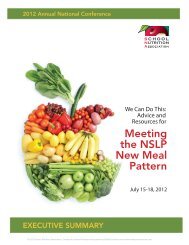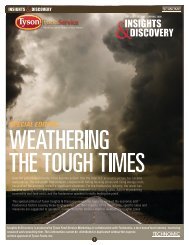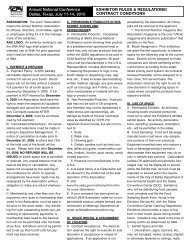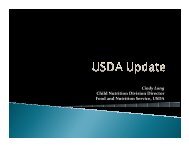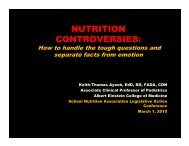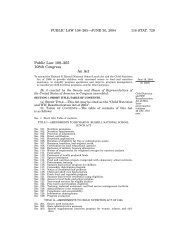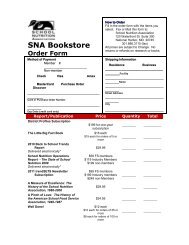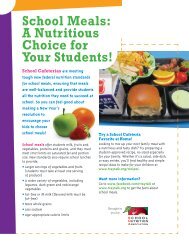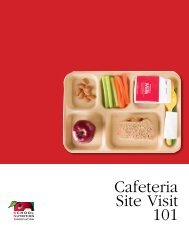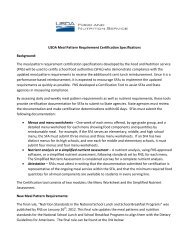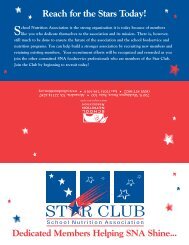food allergy policy & guidelines - School Nutrition Association
food allergy policy & guidelines - School Nutrition Association
food allergy policy & guidelines - School Nutrition Association
You also want an ePaper? Increase the reach of your titles
YUMPU automatically turns print PDFs into web optimized ePapers that Google loves.
]<br />
LIBERTY<br />
PUBLIC<br />
SCHOOL<br />
DISTRICT<br />
FOOD ALLERGY POLICY & GUIDELINES
Allergy Management Policy<br />
Board Policy JHC<br />
Liberty Public <strong>School</strong>s is committed to providing a safe and nurturing environment for students.<br />
The Liberty Board of Education understands the increasing prevalence of life threatening allergies<br />
among school populations. Recognizing that the risk of accidental exposure to allergens can be<br />
reduced in the school setting, Liberty Public <strong>School</strong>s is committed to working in cooperation with<br />
parents, students, and physicians, to minimize risks and provide a safe educational environment<br />
for all students. The focus of <strong>allergy</strong> management shall be on prevention, education, awareness,<br />
communication and emergency response.<br />
The goals for <strong>allergy</strong> management include:<br />
1. To define a formal process for identifying, managing, and ensuring continuity of care for<br />
students with life-threatening allergies across all transitions (PreK-12). This process shall be<br />
outlined in detail in the district’s administrative procedures manual.<br />
2. To maintain the health and protect the safety of children who have life-threatening allergies<br />
in ways that are developmentally appropriate, promote self-advocacy and competence in<br />
self-care and provide appropriate educational opportunities.<br />
3. To ensure that interventions and individual health care plans for students with lifethreatening<br />
allergies are based on medically accurate information and evidence-based<br />
practices.<br />
In accordance with applicable law, it is the <strong>policy</strong> of the district to provide all students, through<br />
necessary accommodations where required, the opportunity to participate in all school programs<br />
and activities. Accordingly, the superintendent shall direct executive directors, district building<br />
administrators and staff, to act affirmatively and work closely with parents to assure that the needs<br />
of children with documented allergies are taken into consideration in planning for district<br />
programs. The district health services coordinator shall ensure the district’s management plan is<br />
reviewed and updated annually.<br />
1
Life-Threatening Allergy Guidelines<br />
BACKGROUND<br />
Allergic <strong>food</strong> reactions can span a wide range of severity of symptoms. The most severe and<br />
potentially life threatening reaction is anaphylaxis. This protocol is to be used for students who are at<br />
risk for anaphylaxis and in circumstances where a previously undiagnosed life-threatening allergic<br />
response occurs. When a physician assesses that a child’s <strong>food</strong> <strong>allergy</strong> will result in anaphylaxis, the<br />
child’s condition meets the definition of “disability” and is covered under the Federal Americans with<br />
Disability Act (ADA), Section 504 of the Rehabilitation Act of 1973, if the <strong>allergy</strong> management affects<br />
the student’s ability to make educational progress.<br />
The Liberty <strong>School</strong> District has stock epinephrine at each school. The epinephrine will be used in<br />
emergencies for students with unknown allergies who develop an anaphylactic response and for<br />
those students with known allergies when on rare occasions when their personal emergency<br />
medication is found to be flawed.<br />
Anaphylaxis refers to a collection of symptoms affecting multiple systems in the body, the most<br />
dangerous of which are breathing difficulties and a drop in blood pressure. Foods that most<br />
commonly cause anaphylaxis, a life threatening allergic reaction, are peanuts, tree nuts, shellfish,<br />
milk, wheat, soy, fish, and eggs. These severe allergic reactions can occur within minutes of ingestion<br />
or a reaction can be delayed for up to two hours. Some reactions are “biphasic” in nature with an<br />
initial period of symptoms, a symptom free period of 2-3 hours followed by severe shock-like<br />
symptoms. At present there is no cure for <strong>food</strong> allergies and strict avoidance is the key to preventing<br />
reactions. Exposure may occur by eating the <strong>food</strong> or <strong>food</strong> contact.<br />
MEDICATIONS<br />
The most commonly prescribed medications for the treatment of anaphylaxis are:<br />
Epinephrine – Brand names include, but are not limited to EpiPen®, EpiPen Jr® ,Twinject®<br />
autoinjectors. Parents usually bring epinephrine to school in the form of an EpiPen® (0.3 mg),<br />
EpiPen Jr® (0.15 mg) or Twinject® (0.3 mg or 0.15 mg) auto injectors.<br />
Note: The EpiPen® is a single dose auto-injector, while the Twinject® contains two doses of<br />
epinephrine – the first dose in an auto-injector and the second dose in the form of a traditional<br />
injection.<br />
CARE PLAN CONSIDERATIONS/OPTIONS<br />
There are a variety of student accommodation and care plans that are appropriate to use for students<br />
in our schools that experience health conditions that may impact a student’s school day and academic<br />
program. The plans that are most often seen are:<br />
Allergy Action Plan – a plan completed by the student’s licensed physician or physician’s designated<br />
licensed extender, i.e., a Nurse Practitioner or Physician’s Assistant that is designed for use by both<br />
nursing and school personnel. It outlines the care that a student could need in an emergency<br />
situation and used as a guide to respond to a student who is experiencing a potentially critical<br />
situation.<br />
Individual Healthcare Plan for Accommodations – A document developed by the nursing staff in<br />
collaboration with parents and the school team to identify reasonable accommodations for the child’s<br />
needs throughout the school day.<br />
2
Section 504 Plan- The intent of Section 504 of the Rehabilitation Act of 1973 is to provide students<br />
with disabilities equal access to educational programs, services, and activities. Students with<br />
disabilities may not be denied participation in school programs and activities solely on the basis of<br />
disability.<br />
There are substantial differences across the country in legal interpretations and school district<br />
practices regarding Section 504, its definition of a qualified person with a disability, and the eligibility<br />
of students with life-threatening <strong>food</strong> allergies. Since the law provides that a team of knowledgeable<br />
persons must make eligibility determinations on a case-by-case basis, these <strong>guidelines</strong> cannot<br />
provide specific guidance on the eligibility question. Nevertheless, school districts have an obligation<br />
to provide reasonably safe environments for all students. Whether students with life-threatening <strong>food</strong><br />
allergies are identified under Section 504 as disabled individuals or not, Liberty Public <strong>School</strong> will<br />
provide these students with individualized health care plans to address their health and safety needs.<br />
3
Responsibilities of the Parent/Guardian of an Anaphylactic Student<br />
Each parent/guardian of their child with a Life-Threatening Allergy shall have the following<br />
expectations:<br />
1. Teach your child to:<br />
a. Recognize the first symptoms of a <strong>food</strong> allergic/anaphylactic reaction.<br />
b. Communicate with school staff as soon as he/she feels a reaction is starting.<br />
c. Carry his/her own epinephrine auto-injector when appropriate.<br />
d. Not share snacks, lunches, drinks or utensils.<br />
e. Understand the importance of hand washing before and after eating.<br />
f. Report teasing and/or bullying that may relate to the child’s disability.<br />
2. Take responsibility for his/her own safety. As children get older, teach them to:<br />
a. Encourage self-advocacy of the seriousness of the <strong>allergy</strong> to adults and peers.<br />
b. Communicate symptoms as soon as they appear to the school nurse and teacher.<br />
c. Encourage education on label reading and ingredient safety.<br />
d. Administer his/her own epinephrine auto-injector and be able to train others in its use.<br />
e. Develop awareness of their environments, including <strong>allergy</strong>-controlled zones and to<br />
practice age appropriate behavior regarding health and safety.<br />
3. Inform the school nurse of your child’s allergies prior to the opening of school (or as soon as<br />
possible after diagnosis). All <strong>food</strong> allergies must be verified by documentation from<br />
physician or physician’s designated licensed extender (Nurse Practitioner (NP) or<br />
Physician Assistant (PA).<br />
4. Work with the school team collaboratively to develop the Individual Health Plan for<br />
Accommodations, in the classroom, in the cafeteria, in after-care programs, during schoolsponsored<br />
activities, and provide an Allergy Action Plan. Medical information from the child’s<br />
treating physician must be provided as needed to write the Plans. (A licensed physician is<br />
defined as a doctor of medicine (MD) or a doctor of osteopathy (DO) is recognized.)<br />
5. The Plan should also promote increasing age-appropriate independence (ages 8 -18) as the<br />
student grows and matures. In determining age-appropriate independence the student’s level<br />
of autonomy and their ability to function autonomously is considered.<br />
6. Complete and submit all required medication forms.<br />
7. A physician signature is required on district <strong>allergy</strong> action plans and self-administration plan.<br />
Sign release for school personnel to consult with family physician/allergist and all medical<br />
providers.<br />
8. Provide the school with current cell phone, pager, etc and maintain updated emergency<br />
contact numbers and medical information.<br />
9. Provide the school nurse with up-to-date emergency medications (including Epinephrine) so<br />
they can be placed in all required locations for the current school year. Medications will comply<br />
with the district medication <strong>policy</strong> of proper labeling and expiration.<br />
10. To consider providing a medical alert bracelet for your child. Nationally accepted bracelets<br />
may be found at: Medic Alert,1-800-432-5378; 2323 Colorado Avenue, Turlock, CA 95382;<br />
www.medicalalert.org<br />
11. To complete appropriate forms requested by Transportation or other appropriate departments<br />
and/or programs.<br />
12. Provide Epinephrine on field trips.<br />
13. To go on your student’s field trips if possible and if requested.<br />
14. To provide “safe snacks for your student’s classroom so there is always something your child<br />
can choose from during an unplanned special event.<br />
15. Encourage child to wash hands before and after handling <strong>food</strong>. Encourage child to identify the<br />
<strong>allergy</strong> controlled zone when eating and to utilize easy access to soap in or near classrooms.<br />
16. Inform the school of any changes in the child’s Life-threatening Food Allergy status.<br />
17. Provide the school with the physician’s statement if the student no longer has <strong>food</strong> allergies.<br />
4
EXPECTATIONS OF STUDENT<br />
Each student with a Life-Threatening Allergy shall be expected for the following:<br />
1. To develop a relationship with the school nurse and/or another trusted adult in the school to<br />
assist in identifying issues related to the management of the <strong>food</strong> <strong>allergy</strong> in the school.<br />
(Trusted adults are people who respect your feelings will listen and help work out a solution to<br />
any problem you may have. Trusted adults will provide guidance and support).<br />
2. Use proper hand washing before and after eating and throughout the school day.<br />
3. To avoid sharing or trading of <strong>food</strong>s or eating utensils with others. Take responsibility for<br />
avoiding <strong>food</strong> allergens.<br />
4. To not eat anything with unknown ingredients or known to contain any allergen.<br />
5. To avoid putting anything in mouth such as writing utensils, fingers, or other foreign object.<br />
6. To be proactive in the care and management of their <strong>food</strong> allergies and reactions based on<br />
their developmental level. Learn to recognize personal symptoms.<br />
7. To notify an adult immediately if they eat something they believe may contain the <strong>food</strong> to<br />
which they are allergic.<br />
8. To notify an adult if they are being picked on or threatened by other students as it relates to<br />
their <strong>food</strong> <strong>allergy</strong>.<br />
9. To keep emergency epinephrine with the student, in the nurse’s office or in the classroom. If<br />
the student is authorized to carry the emergency medication with them at all times, he/she will<br />
demonstrate responsibility of this practice by completing the skills checklist with the school<br />
nurse (found in the appendix within the Epinephrine Self-Administration Authorization packet<br />
for Anaphylaxis).<br />
10. To develop an awareness of their environment and their <strong>allergy</strong>-controlled zones.<br />
11. Should know the overall Individual Healthcare Plan and understand the responsibilities of the<br />
plan.<br />
12. To develop greater independence to keep themselves safe from anaphylactic reactions.<br />
RESPONSIBILITIES OF SCHOOL ADMINISTRATOR<br />
Liberty Public <strong>School</strong>s <strong>School</strong> Administrator shall ensure the following:<br />
1. Follow all applicable federal laws, including ADA, Section 504, and FERPA, as well as all state<br />
laws and district policies/<strong>guidelines</strong> that may apply.<br />
2. To have available the appropriate <strong>allergy</strong> forms to the parent and explain that the required<br />
forms must be returned and approved by the school nurse prior to the child attending school.<br />
3. Meet with parents and listen to their needs and concerns.<br />
4. The HIPAA Compliant Authorization for Exchange of Health & Education Information will be<br />
presented to parents for signature to provide needed communication between the supervising<br />
physician and school for effective implementation of the plan.<br />
5. Establish a core team comprised of Parent, Principal, Teacher, Student, Nurse, Cafeteria<br />
Manager, and other personnel deemed necessary to make decisions about <strong>food</strong> allergies.<br />
6. Create an emergency action plan for addressing life-threatening <strong>food</strong> based allergic reactions<br />
with consulting the school nurse, student’s parent(s)/guardian(s), and physician.<br />
7. Ensure district-wide mandatory in-service training and education on reducing life-threatening<br />
<strong>allergy</strong> risks, recognizing <strong>food</strong> <strong>allergy</strong> symptoms, and emergency procedures for appropriate<br />
staff to include, but not limited to the following topics:<br />
a. A description/definition of severe allergies and a discussion of the most common <strong>food</strong>s<br />
causing allergic reactions.<br />
b. The signs and symptoms of anaphylaxis.<br />
c. The correct use of an Epinephrine.<br />
d. Specific steps to follow in the event of an emergency.<br />
5
In addition, parent/staff severe <strong>allergy</strong> educational meetings may be scheduled as medical<br />
personnel are available.<br />
8. Reinforce a no-<strong>food</strong> and no-utensil trading /sharing best practice will be encouraged. A sign in<br />
each elementary school shall be posted informing students that they are expected to neither<br />
trade nor share <strong>food</strong> or utensils.<br />
9. Ensure that the <strong>School</strong> Nurse in consultation with suggestions from student’s<br />
parent(s)/guardian(s) and the physician or designated licensed extender will prepare the<br />
Individual Health Plan for accommodations. The physician will prepare and sign off on the<br />
Allergy Action Plan.<br />
10. Establish life-threatening <strong>allergy</strong> safe zones as needed in each school cafeteria including<br />
<strong>allergy</strong> safe zones. These zones will be designated by a universal symbol. These zones will<br />
be cleaned and sanitized as per district protocol (see <strong>Nutrition</strong> Services and Custodial<br />
Services Section).<br />
11. Ensure the Individual Health Plan for Accommodations available in the nurse’s office and a<br />
student’s homeroom at the elementary levels and in the nurse’s office at the secondary<br />
schools.<br />
12. Recommend that parents/guardians attach a photograph of their student with a Life-<br />
Threatening Food Allergy to their Individual Health Plan for Accommodations. When<br />
appropriate; student’s photos will be placed in the kitchen only for kitchen staff to view as an<br />
extra protective measure. Pictures will be out of view of other students and carried out in<br />
accordance with patient confidentiality regulations.<br />
13. When appropriate, enforce students are allowed and encouraged to carry their Epinephrine<br />
on them, as allowed by the district’s Administration of Medication Policy and Self-<br />
Administration Epinephrine Authorization Plan.<br />
14. Ensure that information is in an organized, prominent and accessible format for a substitute<br />
teacher with the universal symbol displayed for ease of access. A bright colored label will be<br />
on the outside of sub folders (MEDICAL ALERT:).The medical issue will be filled in the blank<br />
specific to the student.<br />
15. When appropriate, familiarize teachers with the Individual Health Plan for Accommodations of<br />
their students and any other staff member who has contact with student on a need-to-know<br />
basis.<br />
16. Instruct and reinforce with facilities personnel to develop cleaning protocol to ensure that the<br />
threat of allergens is minimized.<br />
17. Establish procedures to ensure letters to all parents of children assigned to a classroom where<br />
one of the students has been identified as having a Life-Threatening Allergy (K-5) and schoolwide<br />
for secondary students. This will be carried out in accordance with patient confidentiality<br />
regulations.<br />
18. The school’s emergency protocol on Life-Threatening Allergies will be posted in appropriate<br />
locations, i.e. nurse office, main office and other areas as designated by the Building Principal.<br />
Communication will also be enclosed in the Back-to-<strong>School</strong> Newsletter.<br />
19. Notify staff of the locations of Epinephrine’s in the school.<br />
20. A contingency plan will be in place using designated building staff and understood by all staff<br />
and students in the event the nurse is not in the office or in the building. Staff will call 911 in all<br />
instances of Epinephrine administration.<br />
6
RESPONSIBILITIES OF SCHOOL HEALTH PROFESSIONALS<br />
The school nurse is the primary coordinator of each student’s life-threatening <strong>allergy</strong> plan.<br />
Each school nurse will have the following responsibilities:<br />
1. Meet with parent/guardian(s) of a student with a Life-Threatening Allergy to develop an<br />
Individual Health Plan for Accommodations for the student, which may include the use of<br />
MEDIC-ALERT bracelets and other methods of identification for students with Life-Threatening<br />
Allergies.<br />
2. Maintain updated AAP/Individual Health Plan for Accommodations in the nurse’s office, in the<br />
classroom when appropriate, and with Epinephrine’s that are carried by identified students.<br />
The emergency action plans will also travel with the Epinephrine’s on school sponsored field<br />
trips.<br />
3. Assist the principal in providing information about students with Life-Threatening Allergies to<br />
staff where there is a need-to-know basis.<br />
4. In conjunction with the principal, provide yearly in-service training and education for staff<br />
regarding Life-Threatening Allergies, symptoms, risk reduction procedures and emergency<br />
procedures including demonstration on how to use the Epinephrine. The school nurse shall<br />
retain documentation of those personnel who have received training on a yearly basis.<br />
5. Familiarize teachers/substitutes with the Individual Health Plan for Accommodations of their<br />
students and any other staff member who has contact with student on need-to-know basis.<br />
6. The Department of Health and Senior Services <strong>guidelines</strong> and The Missouri State Board<br />
Nurse Practice Act governing the administration of prescription medications, and school board<br />
<strong>policy</strong> will be followed in emergency situations. Nurses are responsible for following the<br />
regulations that permit registration of non-licensed personnel to be trained and to administer<br />
emergency medications such as Epinephrine.<br />
7. Educate with parents the appropriate locations for storing the Epinephrine and the possibility<br />
of receiving more than one Epinephrine as necessary. Locations for storage will follow the<br />
manufacturer’s <strong>guidelines</strong> for avoidance of light and extreme temperatures.<br />
8. Inform the school principal and parent/guardian if any student experiences an allergic reaction<br />
that has not been previously diagnosed.<br />
9. Contingency plan will be in place in the event the nurse is not in the building utilizing trained<br />
and identified back-up personnel.<br />
RESPONSIBLITIES OF TEACHERS<br />
Each teacher shall have the following responsibilities:<br />
1. Knowledge of the signs and symptoms of severe allergic reaction as provided in the student’s<br />
health care plan, and be aware of and implement the emergency plan if a reaction is<br />
suspected.<br />
2. Review the Individual Health Plan for Accommodations in a setting with the nurse and<br />
parent(s)/guardian(s) of any student in your classroom with life-threatening allergies along with<br />
relevant staff members.<br />
3. Participate in in-service training about students with life-threatening allergies including<br />
demonstration on how to use the Epinephrine.<br />
4. In collaboration with the nurse and parent(s)/guardian(s) of the allergic child, will set a<br />
classroom protocol regarding the management of <strong>food</strong> in the classroom. This protocol will be<br />
communicated by the teacher to the students and parent(s)/guardian(s) of the affected class.<br />
5. Participate in the planning of a student’s re-entry into school after an anaphylactic reaction.<br />
6. Notify parents by written communication of any school related activity that requires the use of<br />
<strong>food</strong> in advance of the project or activity (K-9). (Learning activities will be controlled as much<br />
as possible) Limit use of <strong>food</strong> for instructional lessons.<br />
7
7. Collaborate with administration, nurse, and parents to send out letters to all<br />
parent(s)/guardian(s) of students in a class with an individual with a Life-Threatening Allergy<br />
announcing potential <strong>food</strong> use instructionally.<br />
8. Reinforce appropriate classroom hygiene practices/hand washing before and after eating.<br />
9. Respond immediately to reports of students being teased or bullied about their <strong>food</strong> allergies.<br />
10. Follow Allergy Action Plan and call 911 when life-threatening <strong>allergy</strong> related symptoms occur.<br />
RESPONSIBILITIES OF NUTRITION SERVICES<br />
The nutrition services department shall:<br />
1. Provide in-service to nutritional service employees regarding safe <strong>food</strong> handling practices to<br />
avoid cross contamination with potential <strong>food</strong> allergens.<br />
2. Food service employees will wear non-latex gloves. Gloved hands will be washed or changed<br />
during extended use to avoid cross contamination with potential <strong>food</strong> allergens.<br />
3. Maintain a list of students with <strong>food</strong> allergies within the <strong>food</strong> service area with a photo of the<br />
student wherever possible. (not for public viewing)<br />
4. Maintain knowledge of which <strong>food</strong> products contain allergens.<br />
5. Provide allergen-safe zones at schools where students with applicable <strong>food</strong> allergies are<br />
identified with universal symbol.<br />
6. Participate in in-service training for students with life-threatening allergies including<br />
demonstration of Epinephrine use.<br />
7. With parental approval, set up reasonable procedures for cafeteria regarding <strong>food</strong> allergic<br />
students, including entering student’s <strong>allergy</strong> into computerized database. Information will<br />
remain confidential and shared on a need-to-know basis in compliance with federal privacy<br />
regulations.<br />
8. Respond appropriately to all complaints/concerns from any student with a life-threatening<br />
<strong>allergy</strong>, including allowing student to see school nurse if complaining of any potential<br />
symptoms. A response to complaints/concerns would also include any type of hazing or<br />
inappropriate behavior on the part of other students.<br />
RESPONSIBILITIES OF CUSTODIAL SERVICES<br />
The custodial service department shall under the direction of the Building Principal:<br />
1. Use a separate wash bucket and cloth with district-approved cleaning agents solely for the<br />
cleaning of allergen–safe zones. This will include disinfecting solution and PH7 all-purpose<br />
soap as effective cleaning solutions.<br />
2. Receive training on allergen zone maintenance areas.<br />
3. Participate in in-service training for students with life-threatening allergies including<br />
demonstration of Epinephrine use.<br />
RESPONSIBILITIES OF THE TRANSPORTATION DEPARTMENT<br />
All school bus drivers shall be informed when he/she is transporting a child with a Life-Threatening<br />
Allergy. The school bus drivers shall:<br />
1. The transportation department maintains health concern files separately from those<br />
maintained at each school. When a student is added to a bus route, a transportation health<br />
concern form is mailed home to the parent(s)/guardian(s). It is the parent(s)/guardian(s)<br />
responsibility to communicate health concerns such as a life-threatening <strong>allergy</strong> directly to the<br />
transportation department by returning the completed form (see Transportation Section).<br />
2. Have functioning emergency communication devices (e.g., cell phones, two-way radios, etc.)<br />
on each bus.<br />
8
3. Maintain and reinforce <strong>policy</strong> of no <strong>food</strong> eating on the bus except for those medically<br />
documented needs, i.e., diabetics. In cases of medically documented needs, those students<br />
must bring allergen safe <strong>food</strong>s for eating on the bus.<br />
4. Students with life-threatening allergies should sit immediately behind and to the right side of<br />
the bus driver when transporting to/from school.<br />
5. Bus drivers will not hand out <strong>food</strong> treats even on special occasions.<br />
6. Provide all students using district transportation with the transportation health concerns form<br />
and maintain a list of students with identified health concerns including anaphylactic risk.<br />
7. Participate in in-service training for students with life-threatening allergies including<br />
demonstration of how to use the Epinephrine.<br />
RESPONSIBILITIES OF PERSONS IN CHARGE OF CONDUCTING AFTER-SCHOOL ACTIVITIES<br />
Person(s) in charge of extracurricular programs shall have the following responsibilities:<br />
1. The Allergy Action Plan will be available for parents to copy and give to others who assume<br />
responsibility for their child. Personnel may include:<br />
a. Before or after school activity instructors<br />
b. Coaches<br />
c. Kids Zone/Child Care<br />
d. Overnight tournament sponsors or district chaperones<br />
e. Clubs, programs, or sports will maintain a list of students with severe life-threatening<br />
allergies. These individual programs will be responsible for obtaining this information<br />
from parent(s)/guardian(s).<br />
2. District employees will participate in in-service training about students with life-threatening<br />
allergies including demonstration of Epinephrine use at least annually. The training will be<br />
documented and kept on file.<br />
RESPONSIBILITIES DURING RECESS AND PHYSICAL EDUCATION CLASSES<br />
During recess and physical education classes for a student with a Life-Threatening Allergy, the school<br />
shall have the following responsibilities:<br />
1. Children will be under the supervision of at least one adult. Epinephrine Packet will be taken<br />
outside if specified in the child’s Allergy Action Plan/Individual Health Plan for<br />
Accommodations. The epinephrine will be carried by a designated district employee or by the<br />
student with a completed Epinephrine Self-Administration Packet for Anaphylaxis.<br />
2. Emergency communication device (walkie-talkie, cell phone) will be accessible and functional.<br />
RESPONSIBILITIES ON FIELD TRIPS<br />
The school shall have the following responsibilities when a student with Life-Threatening Food Allergy<br />
attends field trips:<br />
1. On field trips consideration given for avoiding <strong>food</strong> allergen exposure, and parental attendance<br />
is encouaged.<br />
2. Meals of children with <strong>food</strong> allergies should be stored separately to minimize cross<br />
contamination.<br />
3. An in-serviced trained district employee such as the classroom teacher will accompany the<br />
class on the field trip and will maintain each applicable student’s Epinephrine and will follow<br />
the child’s Allergy Action Plan/IHCP.<br />
4. Copies of student’s Allergy Action Plan will be carried on all field trips.<br />
5. Staff will call 911 in all instances of Epinephrine use. Parent(s)/Legal Guardian(s) will be<br />
notified.<br />
9
KEY POINTS FOR PARENTS, STUDENTS AND STAFF<br />
• You are never alone. It takes a team to ensure the best for our students. Help is usually a<br />
phone call away.<br />
• Educate, Educate, Educate. This is an ongoing process that changes with the students’<br />
needs and as the staff changes. Food bans do not work because it creates a false sense of<br />
security. Today, processed <strong>food</strong>s contain trace amounts of <strong>food</strong> items that are not always<br />
identified on the <strong>food</strong> label. The best plan is to educate our school community about the<br />
issues that face students with life threatening allergies.<br />
• Special events/Non-routine days. The greatest risk for a life threatening allergic reaction<br />
exists when the normal routine is broken. Examples are classroom parties, field trips, a<br />
substitute teacher, and after school events. Be Prepared. Always have the Allergy Action<br />
Plan (AAP) available and think ahead to prevent possible exposures to a <strong>food</strong> allergen.<br />
• Symptoms vary greatly. Call 911 when uncontrolled anaphylactic symptoms occur or if<br />
ingestion is strongly suspected. Use emergency medication (i.e. Epinephrine) if needed and<br />
follow the AAP<br />
• Be safe, not sorry! Take all complaints from children with <strong>food</strong> allergies very, very<br />
seriously. It is important to respect the needs and rights of each student.<br />
• A child with a life threatening <strong>food</strong> <strong>allergy</strong> should NEVER eat unexamined <strong>food</strong>.<br />
• In the event a student has an allergic reaction at school, call 911 and administer<br />
emergency medication (i.e. antihistamine and Epinephrine) as ordered by the student’s<br />
physician. Key staff members should be trained to use emergency medications and know the<br />
location of those medications at school and on any special function. If epinephrine<br />
(Epinephrine) is used, the student should be taken to the hospital for evaluation even if<br />
the allergic reaction symptoms subside. The school principal, nurse and parent/guardian<br />
should be notified as soon as feasible. 911 should be called for all suspected <strong>food</strong> <strong>allergy</strong><br />
reactions. No one can predict how a reaction will progress. A mild reaction can blossom into<br />
a full blown anaphylactic reaction very quickly or over several hours. A reaction can also<br />
appear to subside or even appear to be under control and can blossom again into a more<br />
severe reaction.<br />
• Cross contamination. It only takes a trace amount of the <strong>food</strong> protein to cause an allergic<br />
reaction. To prevent exposure to an allergen, hand washing and washing of surfaces<br />
(tables, chairs, mixing bowls, etc.) where an allergen has been used is necessary. Soap and<br />
warm water are most effective for cleaning surfaces.<br />
Be prepared! Know your plan!<br />
10
RESOURCES<br />
The Food Allergy and Anaphylaxis Network (FAAN). FAN is a great resource for current<br />
research, informational newsletter, support groups, and information of <strong>food</strong> products. Their<br />
phone number is 800-929-4040, and the Web address is: www.<strong>food</strong><strong>allergy</strong>.org<br />
American Academy of Allergy, Asthma and Immunology. (AAAAI). http://www.aaaai.org<br />
National <strong>Association</strong> of <strong>School</strong> Nurses. http://www.nasn.org<br />
Asthma & Allergy Foundation of America. http://www.aafa.org<br />
• The Food Allergy & Anaphylaxis Network (FAAN)<br />
FAAN is a great resource for current research, informational newsletter, support groups,<br />
and information of <strong>food</strong> products. Their phone number is 1-800-929-4040.<br />
• Allergy, Asthma Information <strong>Association</strong> of Canada (AAIA)<br />
• American Academy of Allergy, Asthma & Immunology (AAAAI)<br />
• National <strong>Association</strong> of <strong>School</strong> Nurses (NASN)<br />
• Asthma & Allergy Foundation of America (AAFA)<br />
• Food & Drug Administration's Website<br />
• Food Anaphylaxis Education's Website<br />
11
FORMS:<br />
Epinephrine Fact Sheet<br />
Sample Parent Letter<br />
Food Allergy and Epinephrine Training In-Service Sheet<br />
Epinephrine Self-Administration Authorization Packet for Anaphylaxis<br />
Food Allergy Action Plan<br />
Epinephrine/Twinject Medication Self-Administration Form<br />
Epinephrine/Twinject Student Skills Checklist<br />
Transportation/Food Services Letter to Parents<br />
Substitute Notice<br />
Allergen-Safe zone sign<br />
No Food or Utensil Sharing sign<br />
12
(on building letterhead)<br />
DATE<br />
Dear Parents,<br />
This year at name of school we have many students with <strong>food</strong> allergies and a few students<br />
who have a life-threatening peanut <strong>allergy</strong>. Students have been provided with a pamphlet<br />
entitled “Be a PAL” that provides information on <strong>food</strong> allergies and ways they can keep their<br />
friends safe at school. Classroom teachers and staff have been provided a <strong>food</strong>s to avoid list.<br />
Name of <strong>School</strong> staff is working hard to control allergen exposure in the classroom as much<br />
as possible so please check with teachers prior to sending in snacks and always include the<br />
packaging.<br />
In addition, our cafeteria will have a designated <strong>allergy</strong>-controlled zone. Any student may sit<br />
at that table provided they are not eating peanut butter or a nut product. We have many <strong>food</strong><br />
items available in our cafeteria that are safe for students with peanut allergies. The ala carte<br />
<strong>food</strong> items that have possible allergens such as egg, soy, or peanuts, will have those<br />
ingredients posted.<br />
As has always been our district <strong>policy</strong>, <strong>food</strong> must be commercially prepared. Please do not<br />
send homemade treats to school. If your child has a specific <strong>food</strong> need you may send snacks<br />
that are safe for your child to eat. These snacks however, must be stored with the classroom<br />
teacher or his/her designee such as a substitute. Your child can access these snacks when<br />
treats are eaten in class.<br />
If you child has any special <strong>food</strong> need and you have not made the school aware please call<br />
our school nurse, nurse name and phone number. Thank you in advance for your<br />
cooperation, as we work together to keep our school safe for all students.<br />
Sincerely,<br />
Principal Name and Title<br />
Nurse Name and Credentials<br />
13
Food Allergy and Epinephrine Training In-Service<br />
Date:_________________<br />
Name(Print):_________________________________ Bldg:______________________________<br />
*I have received information regarding <strong>food</strong> allergies, signs, and symptoms of<br />
an allergic reaction and possible <strong>allergy</strong> triggers.<br />
*I have received a list of safe <strong>food</strong>s/<strong>allergy</strong>-controlled <strong>food</strong>s and understand it is<br />
my responsibility to check all <strong>food</strong>s/ingredients prior to classroom consumption.<br />
*I have received information on how to clean possible contaminated surfaces.<br />
*I have demonstrated how to administer an Epinephrine.<br />
Signature: _______________________________________<br />
Cc: personnel file<br />
14
Epinephrine Self-Administration<br />
Authorization Packet for Anaphylaxis<br />
(A new packet must be completed yearly)<br />
Packet Contents:<br />
1. Anaphylaxis Medication Self-Administration Form (requires<br />
physician and parent/guardian signature)<br />
2. Anaphylaxis Student Skills Checklist<br />
3. Severe Allergy Action Plan (requires physician and<br />
parent/guardian signature)<br />
4. Missouri Revised Statutes – August 2006<br />
15
Revised May, 2007<br />
16
EPINEPHRINE/TWINJECT MEDICATION SELF-ADMINISTRATION FORM<br />
Student Name: ____________________________________Grade: _____ <strong>School</strong> Year: ____________<br />
The Missouri Safe <strong>School</strong>s Act of 1996 provides for students to carry and self-administer life-saving<br />
medications when the following criteria are met:<br />
(1) A licensed physician prescribed or ordered the medication for use by the child and instructed such child in<br />
the correct and responsible use of the medication.<br />
(2) The child has demonstrated to the child’s licensed physician or the licensed physician's designee, and the<br />
school nurse, if available, the skill level necessary to use the medication and any device necessary to<br />
administer such medication prescribed or ordered.<br />
(3) The child's physician has approved and signed a written treatment plan for managing asthma or<br />
anaphylaxis episodes of the child and for medication for use by the child. Such plan shall include a statement<br />
that the child is capable of self-administering the medication under the treatment plan.<br />
(4) The child’s parent or guardian has completed and submitted to the school any written documentation<br />
required by the school, including the treatment plan required in (3) above and the liability statement required in<br />
(5) below.<br />
(5) The child’s parent or guardian has signed a statement acknowledging that the school district and its<br />
employees or agents shall incur no liability as a result of any injury arising from the self-administration of<br />
medication by the child or the administration of such medication by school staff. Such statement shall not be<br />
construed to release the school district and its employees or agents from liability for negligence. (Missouri<br />
Revised Statute; Chapter 176; Pupils and Special Services; Section 167.627; 08-28-2006).<br />
MEDICATION NAME ______________Dose _____________Time or Interval______________<br />
Route/Inhalation device______________________Instructions_________________________<br />
MEDICATION NAME ______________Dose _____________Time or Interval______________<br />
Route/Inhalation device______________________Instructions_________________________<br />
ALLERGIES: List known allergies to medications, <strong>food</strong>s, or air-borne substances<br />
________________________________________________________________________________________<br />
________________________________________________________________________________________<br />
I, the parent or legal guardian of the student listed above, give permission for this child to carry and selfadminister<br />
the above listed medications. I have instructed my child to notify the school staff anytime this device<br />
is used. I understand that, absent any negligence, the school shall incur no liability as a result of any injury<br />
arising from the self-administration of medication by my child.<br />
Signature of parent or legal guardian___________________________________________Date_____________<br />
Parent/Guardian:<br />
Name: _______________________________________________Home phone: _________________________<br />
Address: ___________________________________________ Work and cell phones: ___________________<br />
Name: _____________________________________________ Home phone: __________________________<br />
Address: ___________________________________________ Work and cell phones: __________________<br />
Emergency _ Contact:<br />
Name: _____________________________________________ Phone #’s: ____________________________<br />
Epinephrine/TwinJEct Student Skills Checklist<br />
Epinephrine/TwinJect Student Skills Checklist<br />
I, a licensed physician or nurse practitioner, certify that this child has a medical history of severe allergic<br />
reactions, has been trained in the use of the listed medication, and is judged to be capable of carrying and selfadministering<br />
the listed medications(s). The child should notify school staff anytime the medication/injector is<br />
Student __________________________________ Age _______ Grade/Team _____________<br />
used. This child understands the hazards of sharing medications with others and has agreed to refrain from this<br />
practice.<br />
Signature of Health Care Provider ________________________________________ Date ________________<br />
18<br />
Name of Health Care Provider ___________________________ Phone: ____________ Fax: ______________<br />
Address: _______________________________________ City: ________________ Zip: _________________
<strong>School</strong> Nurse Signature ______________________________________ Date ______________<br />
Epinephrine Pen Trainer Skills Checklist:<br />
_____ Requires Supervision<br />
_____ Performs Independently<br />
1. CONFIRM THAT LABEL STATES TRAINING DEVICE. Remove the gray safety cap.<br />
2. Firmly hold the Epi-Pen with the black tip near the outer aspect of the thigh.<br />
3. Swing and jab firmly into outer thigh and hold the Epi-Pen against the thigh for 10 seconds.<br />
4. Remove the Epi-pen unit and massage injection area for 10 seconds.<br />
5. Replace the gray cap.<br />
6. You may practice again.<br />
7. Verbalize that you will tell the school nurse whenever you use the Epinephrine. If the school nurse<br />
is unavailable, you will tell the principal or appropriate district personnel.<br />
Twinject Trainer Skills Checklist:<br />
_____ Requires Supervision<br />
_____ Performs Independently<br />
1. Pull off green end cap, then red end cap.<br />
2. Put gray cap against outer thigh, press down firmly until needle penetrates. Hold for 10 seconds,<br />
then remove.<br />
3. Verbalize that you will tell the school nurse whenever you use the Twinject. If the school nurse is<br />
unavailable, you will tell the principal or appropriate district personnel.<br />
4. Second dose administration:<br />
‣ After you have found the appropriate personnel and if your symptoms don’t improve after 10<br />
minutes, administer second dose:<br />
• Unscrew gray cap and pull syringe from barrel by holding blue collar at<br />
needle base.<br />
• Slide yellow or orange collar off plunger.<br />
• Put needle into thigh through skin, push plunger down all the way, and<br />
remove.<br />
19
Date: __________________<br />
To:<br />
Parents/Guardians<br />
From: Director of Transportation<br />
Director of <strong>Nutrition</strong>al Services<br />
There are students in The Liberty <strong>School</strong> District who have severe life-threatening allergies. If these<br />
children are exposed to any peanut, nut products, or designated <strong>food</strong> allergen it could be life threatening.<br />
We are working on educating all staff, children and families about ways to reduce the risks to these<br />
children.<br />
We are informing you so that you will help us to provide a safe environment on the bus. Washing hands<br />
and faces, particularly if peanut or nut products have been eaten for breakfast, will help ensure a safe bus<br />
ride for these students. Peanut and nut oils can remain on the hands and face and need to be washed off<br />
well with soap and water.<br />
There will be absolutely NO EATING on the school buses to and from school each day. For your<br />
information, we have set up “<strong>allergy</strong>-controlled” zones in the school cafeterias where this is necessary.<br />
Only children who do not have nut products or designated <strong>food</strong> allergens in their lunch may sit in the<br />
“<strong>allergy</strong>-controlled” zone.<br />
If you have any transportation questions please feel free to call ______________________. For questions<br />
regarding the cafeteria please call _________________________.<br />
You may also call the school nurse at your child’s school to discuss any of your questions or concerns.<br />
Thank you for your help and support in keeping our schools and buses healthy and a safe environment for<br />
all of us.<br />
20
Notice to All Substitutes<br />
***IMPORTANT***<br />
Our building has several students who have severe, LIFE-THREATENING <strong>food</strong><br />
allergies. For these students, eating or touching any nuts or products containing<br />
nuts or other <strong>food</strong> allergens such as dairy or shellfish could result in a potentially<br />
fatal allergic reaction.<br />
As you begin today, immediately check with the office professionals or person to<br />
who you report to learn about life-threatening allergies or students with other health<br />
concerns with whom you will work. If you are a substitute, check the appropriate sub<br />
folder for further information. All health information is CONFIDENTIAL.<br />
Our staff is trained in how to respond to students with <strong>food</strong> allergies in the event of<br />
an accidental exposure, but prevention is the most important action we can all take.<br />
To help reduce the risk of exposure for students with severe allergies, please:<br />
1. Wash your hands after eating or touching any <strong>food</strong>s.<br />
2. Do not eat or bring any <strong>food</strong> items into classrooms or specials classrooms<br />
without first checking with the teacher of that room.<br />
3. Observe the signs posted outside ALL rooms or areas that indicate that no<br />
nuts or other allergens are allowed in those areas.<br />
4. Do not offer <strong>food</strong> to any student.<br />
5. Children should not engage in sharing of <strong>food</strong>.<br />
6. Do not let students take <strong>food</strong> out to the playground.<br />
Thank you for your cooperation in this important matter.<br />
Questions? Contact school nurse:_____________________________ Pager:______________<br />
21
This is a<br />
ALLERGY-<br />
CONTROLLED<br />
ZONE<br />
23
This is a<br />
ALLERGY-<br />
CONTROLLED<br />
CLASSROOM<br />
24



